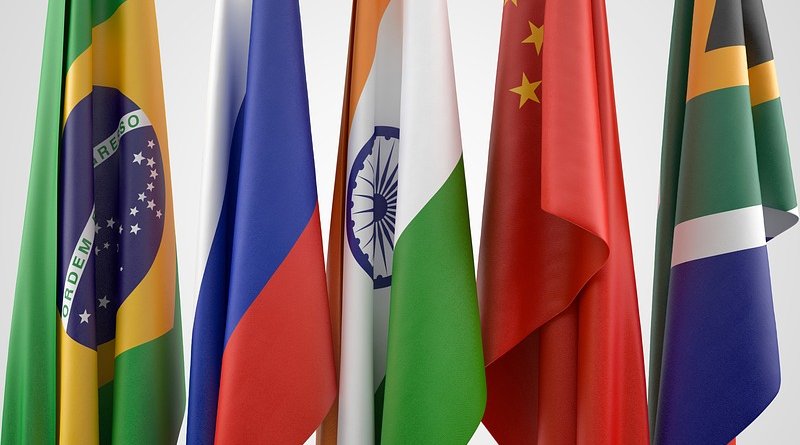Are Cracks Between BRICS Beginning To Show? – OpEd
By Arab News
By Andrew Hammond*
Russian President Vladimir Putin is making final preparations to host the 2020 BRICS summit on Tuesday for his Brazilian, Indian, Chinese and South African counterparts.
While the bloc increasingly projects itself as a unified forum of key emerging markets, the differences between the five members are sometimes just as striking.
Politically, for instance, this year there have been rising tensions between China and India. Bilateral border tensions in Ladakh have worsened and at least 20 Indian soldiers were killed in June alone during clashes with Chinese counterparts. Casualties among the latter are unknown.
Indian ministers have had face-to-face meetings with their Chinese counterparts about the border stand-off. However, there appears to be little prospect of an imminent breakthrough, with both sides digging in with the onset of winter.
The original rationale for the club’s formation was to enjoy economic benefits, but even here there are stark differences that have only been accentuated by the coronavirus (COVID-19) pandemic. China might be the only BRICS economy to expand this year, according to the International Monetary Fund (IMF).
The IMF predicts that despite facing its own coronavirus challenges at the start of the year in Wuhan, the world’s second-largest economy will end the year 1.9 percent bigger after recovering from a 6.8 percent contraction during the first quarter. That compares with forecast contractions of 10.3 percent overall in India, 8 percent in South Africa, 5.8 percent in Brazil and 4.2 percent in Russia.
While this data is striking, China has in fact been an outlier in the group for some time, thanks to sustained economic outperformance. The nation’s real gross domestic product has grown 979.9 percent since 2001, compared with 480.8 percent for second-placed India and 188.9 percent for the group’s laggard, South Africa.
This data not only points to China’s relative success, it also means that there is growing uncertainty over whether the bloc will fulfill the prediction by economist Lord Jim O’Neill — who first coined the concept of BRICS — that it will overtake the G7’s collective economic output in just over a decade.
Whether or not BRICS does overtake the G7 in the time frame proposed by O’Neill, there is no question that its growth is having a major global effect. The five members now account for more than 30 percent of global GDP, on a purchasing parity basis, an increase of more than 10 percentage points from two decades ago.
In addition, World Bank research shows that for the first time in two centuries, overall global income inequality — one of, but not the only, measures of economic inequality — appears to be in decline.
This is being driven by BRICS members, especially the collective economic growth and very large populations of China and India. A massive amount of people in both countries have been lifted out of poverty, driving this greater overall global income equality.
At the same time, however, there is an opposing force: Growing income inequality within many other countries. This has also assumed growing political salience recently as it helps to fuel political populism.
These countervailing pressures are, like tectonic plates, pushing against each other. While the net global trend for the past 200 years has been toward greater overall income inequality, there is growing evidence in the past two decades to suggest that the “positive effect” of growing income equality between countries, spurred by key BRICS members, is superseding the “negative effect” of increasing inequality within nations.
Monumental as this could be, the picture is not yet clear cut. What is certain, however, is that, overall, the lot of the southern nations has improved dramatically, as exemplified by key BRICS members over the past generation. This is partly why the five nations continue to value their membership of the club, despite the differences between them.
Post-pandemic, it is unclear whether BRICS, and the wider development of the global South, will have enough momentum to keep driving forwards toward a more equitable world order, and this will be one of the items on the agenda during Tuesday’s summit.
The answer to that question will depend largely on the twin issues of whether emerging markets generally continue to grow robustly, and whether the trend toward rising income inequality within countries is sustained.
On the first issue, the trajectory of the global economy will very probably continue to shift toward the South, and for the foreseeable future many key emerging markets will probably remain robust.
However, the remarkable wave of emerging-market growth witnessed during the past generation might now decelerate, and the global transformation it has produced in recent years might not be repeated.
On the second issue, it is not set in stone that seemingly ever-growing income inequality within countries will continue, especially if there is political will to address it. However, the debate over what long-term reforms should be undertaken to tackle this problem is contested by the left and right sides of the political spectrum across much of the world.
So while the relevance of BRICS as a coherent political and economic club is increasingly questioned, it has helped drive what could be the first period of sustained movement toward greater global income equality for two centuries.
However, the fragile process could yet slip into reverse post-pandemic, especially if growth in China and India flattens significantly in the coming decade.
• Andrew Hammond is an associate at LSE IDEAS at the London School of Economics.

